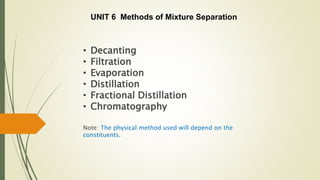
Separation techniques
- 1. • Decanting • Filtration • Evaporation • Distillation • Fractional Distillation • Chromatography Note: The physical method used will depend on the constituents. UNIT 6 Methods of Mixture Separation
- 2. Decanting & Filtration 6.13 (book page 118)
- 5. Method: Filtration Separates: Solid from liquid or solution How it works: solid particles (the residue) are unable to pass through the small gaps between the fibres in the filter paper so remain trapped while the liquid or solution (the fltrate) passes through. Application • Hair in our nostrils trap the dust breathe in and allow only clean air through • Air filters in air conditioners
- 8. KEY WORDS: solute: a solid which will dissolve in a solvent to form a solution solvent: a liquid in which a solute can dissolve solution: a mixture containing one or more solute dissolved in a solvent Method: Evaporation/Crystalization (120) Separates: used to separate a dissolved solid that does not decompose on heating from a solution, e.g. common salt from a salt solution. How it works: The solvent molecules gain enough energy to change state from liquid to gas, and escape making the remaining solution more concentrated. Once the solution has become saturated, removing any more solvent molecules causes the solute to form crystals of the solid material. The solid crystals can be removed from remaining solution by filtration. Used for: Obtaining a sample of crystals of a substance from a solution of the substance.
- 11. Method: Simple Distillation (Book page 121 ) Separates: Liquid from a mixture of liquids, or solvent from a solution How it works: If a solution is heated, the solvent can be evaporated leaving the solute in the flask. If a mixture of liquids is slowly heated, the liquid with the lowest boiling point can be evaporated leaving other liquids in the flask. The evaporated vapour travels into the condenser where it is cooled and condenses to form the distillate which is collected Used for: e.g. Obtaining pure water from salt water (seawater), obtaining pure ethanol (e.g. for a biofuel) from a fermentation mixture
- 12. Method: Fractional Distillation(Book page 122, 123) Separates: Liquids from a mixture of several different liquids How it works: The fractionating column has a temperature gradient; temperature decreases up the column. When each liquid in the mixture reaches its boiling point it evaporates and by slowly increasing the temperature each vapour can be separated and moved into the condenser where it cools and condenses to be collected. Used for: separating the different fractions in crude oil. Note that a similar technique but at very low temperatures can be used to separate the gases in air
- 14. Method: Paper Chromatography (Book page 124) Separates: Different dissolved components of a liquid mixture such as the colouring additives in food, or pigments in inks according to their solubility. How it works: The solubility of each additive determines how fast it will travel up the chromatography paper when carried along by the solvent (the more soluble, the faster the component moves), so the components end up being separated. Insoluble components won’t move at all.
- 15. Setting up: A baseline is drawn in pencil on the chromatography paper (not ink, as it would separate too, interfering with the results). A small spot of the unknown mixture is placed alongside spots of pure substances which may be present (references). The bottom edge of the paper is then dipped in the solvent (usually water) and left while the solvent slowly soaks up to the top of the paper. The solvent level must start below the baseline so that the substances being separated don’t dissolve off the paper into the bulk of the solvent. Results: Each spot in the finished chromatogram is a different substance in the mixture (although sometimes substances with similar solubilities produce spots which are overlapping). A match is found when one of the spots in the unknown sample is the same colour and at the same height (i.e. same Rf value) as a reference spot. An Rf value can be calculated to help identify any spot: Rf = distance spot moved from baseline distance solvent moved from baseline
- 16. pure reference samples of additives foods with unknown additives Interpret the results of this chromatography experiment. How many valid conclusions can you draw? What is the Rf value of mellow yellow ? Practice: where the solvent travelled up to
- 17. APPLICATIONS OF CHROMATOGRAPHY Food industry-------- Scientists use it to Identify nutrients and food additives in food Detective Agencies ------use it to identify and quantify drugs Police forces use it to quantify alcohol in drivers’ blood
- 18. Answers: Conclusions: • Yellow Brightie only contains one colouring additive, which is sunburst yellow. • Orange Brightie contains two colouring additives. One of them is sunny yellow and one of them is solar yellow. • Neither of the sweets contains mellow yellow. • There are no unidentified additives in either of the sweets. Rf value of mellow yellow: Distance mellow yellow spot has travelled from baseline = 68mm Distance solvent front has travelled from baseline = 122mm Rf = 68 ÷ 122 = 0.56